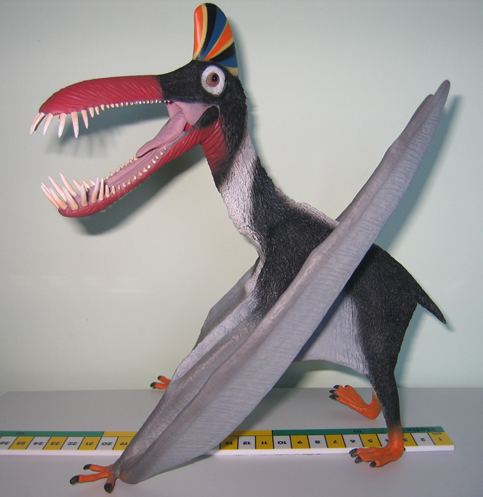Could Pterosaurs really use Water Skimming Techniques to catch Fish?
Almost since the first pterosaur fossils were studied closely scientists have speculated about how good they were at flying and how these flying reptiles might have fed. Since many pterosaur fossils have been found in coastal or marine deposits it is believed that many were piscivores (fish-eaters). The teeth in many primitive pterodactyloids such as Criorhynchus and rhamphorhynchoids like Eudimorphodon seem well suited for grabbing and holding slippery fish. The dentition supports the theory that these animals fed on fish, but how these animals actually captured fish remains a bit of a mystery. The question is, how did pterosaurs feed?
Pterosaur
It had been thought that some pterosaurs used fishing techniques similar to the black skimmer (Rhynchops niger), a tern-like sea bird from the Americas. This bird skims the surface water of lakes and lagoons with its lower mandible ploughing through the water. When a small fish is detected the bill snaps shut.
The lower mandible is larger than the top part of the bill and the skull and jaws are quite robust, able to withstand the stresses of this type of feeding behaviour.
Clumsy in the Air?
In the past, pterosaurs were thought to be clumsy fliers, little able to do more than glide, but more recent studies have shown that these animals were accomplished fliers. For example, on the front of a pterosaur’s long wrist bones (carpus), there was a small bone that curved back towards the shoulder. This is called the pteroid bone and is unique to pterosaurs. At first, palaeontologists thought this to be the atrophied remains of a digit but this extension of bone is now thought to have supported a smaller flight membrane in front of the arm. This smaller wing-like structure in front of the main wing would have helped control the flow of air over the wing, thus controlling speed and altitude. This supports the view that these animals were sophisticated fliers.
A Replica of a Pterosaur (Guidraco)
Picture credit: Everything Dinosaur
Recently scientists at the University of Reading (UK), led by Stuart Humphries have studied the proposed feeding habits of pterosaurs. Using models of the jaws of pterosaurs and a black skimmer, Stuart and his colleagues set up a series of experiments to test whether pterosaurs could use their lower jaws to plough through water hunting for fish.
Results from Experiments
Results from the experiments show that up to 20% more power is required for the animal to keep flying straight when the jaw is immersed in water. As the models skimmed the water in this way, they produced drag which compromised their ability to fly and demanded more muscle activity to keep them airborne. This need for increased power for this type of flight may have prevented flying reptiles from hunting in this way. This evidence, coupled with close studies of pterosaur skulls and jaws which do not show the expected modifications required such as thicker bones to cope with the stresses of this type of foraging makes this team doubt whether pterosaurs fed by skimming.
Keen Eyesight
Perhaps pterosaurs used their relatively keen eyesight to spot prey in the surface water and then swooped down on it plucking the fish out of the water. Jerking the head downwards to permit the jaws to enter the water may provide one of the reasons why many pterosaurs developed complicated crests. These crests could have acted as aerial stabilisers as well as display items for courtship and to intimidate rivals. The rhamphorhynchoids had their heyday in the Jurassic but were replaced with the long-necked pterodactyloids by the Cretaceous. Perhaps the longer necked pterodactyloids had an advantage when feeding by plucking fish from the sea.
Click here to see pterosaur and flying reptile models: Pterosaur and Dinosaur Models.
More study is required, but as more and more remains of pterosaurs are discovered so we may one day be able to solve this mystery.
One of the anomalies with Black Skimmers is that it is easy to get the wrong idea about how these bird feed. When they are featured in nature programmes they are often shown skimming the water. This is certainly a spectacular sight, but documentaries can be misleading. Black Skimmers are just as likely to be seen feeding by wading and stabbing their bills into the water to catch fish, but as this is not as “photogenic” as their aerial acrobatics, it is rarely seen in photographs or TV programmes







[…] To read more about the theory regarding how Pterosaurs such as the Rhamphorhynchidae may have hunted: Pterosaur Feeding Habits – Could they Skim the Water for Fish? […]